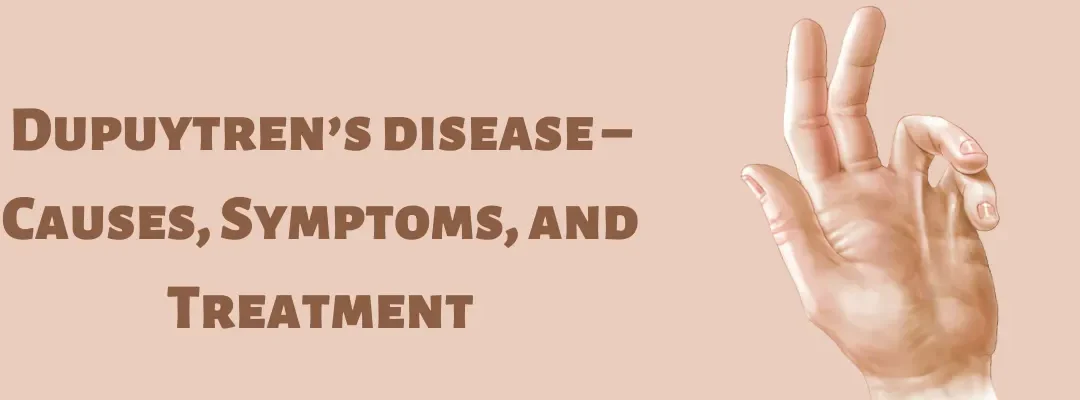A Finger contracture is a deformity of fingers caused by a tightening of the skin and/or any of the underlying tissues including tendon, ligaments, joint capsule, volar plate, etc. It can be caused by any of the following- injury, infection, inflammation, burns, post-surgery, post fracture, tumor, congenital, developmental, etc. scarring.
Contractures can also result from a condition called Dupuytren’s disease where the fascia of the palm and fingers thickens forming cord-like structures pulling the fingers into the palm.
Dr. Leena Jain, among the leading plastic surgeons in Borivali, Mumbai, says that while not painful, Dupuytren’s disease can be quite debilitating, making it difficult to perform everyday tasks such as buttoning a shirt or shaking hands.
Dupuytren’s disease, or Dupuytren’s contracture, is a hand deformity that results in the formation of thick, fibrous bands of tissue in the palm that can pull one or more fingers into a bent/ flexed position. The disorder generally develops slowly over the years and is most commonly seen in people over 50.

What causes Dupuytren’s disease?
The cause of Dupuytren’s disease is not fully understood, although it is thought to have a genetic component.
Some possible risk factors include:
- Age: This condition commonly occurs after the person has crossed 50 years.
- Gender: Men are more prone than women to acquire Dupuytren’s disease and develop more severe contractures.
- Family history: Dupuytren’s disease seems to run in families, so there may be a genetic component to the condition.
- Exposure to certain chemicals: People who work with certain chemicals, such as those used in dry cleaning or leather working, may be more likely to develop Dupuytren’s disease.
- Diabetes: Diabetic people may have a higher risk of getting Dupuytren’s contracture.
- Injury to the hand: An injury to the hand, such as a burn or a cut, may increase the risk of developing Dupuytren’s disease.
- Smoking and alcohol abuse: Smoking is linked to a higher incidence of Dupuytren’s contracture, possibly due to microscopic changes smoking causes in blood vessels. Additionally, drinking alcohol is linked to Dupuytren’s.
- Ancestry: Those of Northern European ancestry are more susceptible to contracting the illness, so much so that it has been dubbed “the Viking disease.”
- It is also associated with tuberculosis
- More common in the west/ Caucasians
If you have been noticing stiffening of your fingers lately, please consult with Dr. Leena Jain, a plastic surgeon in Borivali, Mumbai, for an effective solution.
What are the symptoms of Dupuytren’s disease?

Dupuytren’s disease is a condition that affects the connective tissue in the palm and the fingers.
The symptoms of Dupuytren’s disease include:
- A thickening and shortening of the connective tissue in the palm causing bending of ring and little fingers
- A palpable lump in the palm
- A contracture of the affected fingers, which can limit their range of motion
- Tenderness in the affected area and slight pain in some cases
- Numbness and tingling in the affected fingers, occasionally
These contractures can cause your fingers to bend or curl inwards towards the palm. This condition typically impacts the two fingers furthest from your thumb. The affected fingers may become stiff and difficult to move. In severe cases, the contracture may prevent the hand from opening fully.
If you experience any of these symptoms, it is crucial to see a reconstructive surgeon like Dr. Leena Jain to diagnose and treat the condition properly.
How is Dupuytren’sdisease diagnosed?
Dupuytren’s disease is diagnosed by a physical examination. A physician will look for the characteristic signs and symptoms of the condition, including thickened and hardened skin on your palm and knots of tissue beneath the skin.
If you have a finger contracture, do not hesitate to contact Dr. Leena Jain, an acclaimed reconstructive surgeon in Mumbai, for reliable treatment to prevent the condition from getting worse.
What is the treatment for Dupuytren’s disease in Mumbai?

The most effective treatment for Dupuytren’s disease is surgery.
The core pathophysiology of Dupuytren’s disease is that all of the usual bands in your palm and fingers turn into taut cords, entangling the nerves and blood vessels and causing your finger to bend. Surgery involves cutting the cord that is causing the deformity while safeguarding the finger nerves and blood vessels.
After administering regional or general anesthesia, contracture is released with a zig-zag incision made on skin. The cords are carefully dissected and released from finger nerves and blood vessels to avoid damaging them We prefer to perform this procedure under magnification with a microscope aiding us to meticulously unentangle all the tight cords and adequately straighten the finger while preserving finger nerve and artery.
This surgery can be done as a daycare procedure. Following surgery, a splint is applied for roughly 10 days, during which time exercises and physical therapies are started. The recovery of hand function after surgery and post-operative physical therapy is anticipated to be successful over the long term with no recurrence.
Dr. Leena Jain, a well-known plastic and microsurgeon surgeon with Plastikos Clinic in Mumbai, says that with timely treatment, most people can improve the full range of motion in their affected fingers and regain the use of their hands.
Conclusion

People with Dupuytren’s disease may have difficulty performing everyday tasks, such as writing, cooking, or opening a door. They may also have trouble holding onto objects or completing a firm handshake.
Dr. Leena Jain, a proficient reconstructive plastic surgeon in Mumbai, adds that people affected by this condition can feel highly self-conscious and embarrassed in social situations due to their deformed fingers.
The exact cause of Dupuytren’s disease is unknown, though it is thought to be a combination of genetic and environmental factors. Heredity appears to play a role, as the disorder often runs in families. In addition, people who have diabetes and other medical conditions that affect the palms are at increased risk.
If you have Dupuytren’s disease, you must meet Mumbai’s hand and reconstructive surgeon, Dr. Leena Jain.

